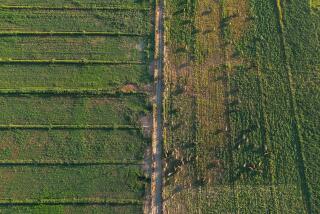Poison Case Undermined by Force That Created It
- Share via
Prosecutors once hailed it as the first oleander poisoning case ever taken to court--a tangled tale of murder that promised to become one of Ventura County’s most sensational trials in years.
But the case of the People vs. David Wayne Sconce, which was dismissed last week in Ventura County Superior Court, began to fall apart early this year, undermined by the very force that created it: science.
It was a Philadelphia toxicologist’s tests showing oleander in the dead man’s remains that led to Sconce’s arrest, and it was a New York professor’s finding of no oleander that prompted Sconce’s release.
Attorneys say that the case might have gone to trial anyway, except for two things: the doubt that a young Ventura County prosecutor felt about his own evidence, and the willingness of Sconce’s attorney to take a gamble.
Sconce, 35, was accused of using extracts from the poisonous oleander bush to kill a business rival, Burbank mortician Timothy R. Waters, who died at his mother’s home in Camarillo six years ago.
The motive for murder, investigators said, was to keep Waters from reporting violations at Sconce’s crematory in Altadena. Sconce had admitted hiring two thugs who beat up Waters two months before he died.
An informant told police that Sconce had bragged about spiking Waters’ drink with poison. Then they learned that Sconce had a book describing oleander as a hard-to-detect poison.
The proof of murder seemed to come in 1988, when Frederick Rieders, a Philadelphia toxicologist, reported finding oleander in Waters’ remains.
Ventura County Dist. Atty. Michael D. Bradbury filed the case in February, 1990, and deputized two veteran Los Angeles County prosecutors, Harvey Giss and James Edward Rogan, to handle it.
Los Angeles County had already convicted Sconce on a number of charges, including the assault on Waters, and the district attorneys in both counties decided that Los Angeles prosecutors should handle the Ventura County case.
But late last year, after Rogan was appointed to a judgeship, Bradbury decided to appoint one of his deputies, Kevin G. DeNoce, to assist Giss.
Giss had just been voted “Prosecutor of the Year” by the California District Attorneys Assn. DeNoce was three years out of Pepperdine University’s law school. But DeNoce brought a scientific background that proved to be crucial.
“Giss asked me if I was willing to handle the toxic and scientific aspects of the case,” DeNoce said last week. “My job was proving that the victim was murdered. His job was proving that the defendant was the one who did the murder. . . .”
After studying Rieders’ test results, DeNoce was worried. “I became concerned that the Rieders methodology was not necessarily substance-specific,” he said.
In other words, something besides oleander could have triggered the positive result in Rieders’ tests.
DeNoce began a nationwide search for the best laboratory to do new tests for oleander.
But Sconce’s attorney, Roger Jon Diamond, was ahead of them.
Diamond said his strategy was to prove there was no murder. He had the body exhumed so a defense expert could examine tissue samples. The lawyer was referred by other experts to Jack Henion, a Cornell University professor. But before Henion agreed to do the work, he got a call from DeNoce.
“About halfway through the conversation,” DeNoce recalled, “he said, ‘By the way, I’ve been contacted by . . . the defense . . . and they might want to use me, too.’ ”
DeNoce said he didn’t object to both sides using the same expert.
Diamond said he thought about raising legal objections but quickly changed his mind.
“Our decision to let them use Henion was the key strategic decision for the defense,” he said.
It was a risky decision: If Henion came back with the slightest finding of oleander or one of its byproducts, Sconce might easily be convicted. But if the scientist found no sign of the poisonous shrub, “How could they repudiate their own expert?” Diamond said.
Henion’s tests were based on precise measurements of the weight of molecular particles, while Rieders’ were essentially behavioral: If it looked like oleander and acted like oleander, it must be oleander.
In his tests, Henion determined how fast an oleandrin molecule moves under certain conditions and subjected the tissue samples to the same conditions. Molecules that moved at the same speed as oleandrin were tested further.
The next set of tests subjected the suspect molecules to bombardment by electrons, which broke the molecules into ions. The ions were weighed and compared with the weight of ions broken down from oleandrin molecules. The weights didn’t match. The samples contained no oleandrin, he concluded.
Bradbury decided to dismiss the case for now and check the remains for other poisons.
DeNoce said Giss supported his call for a new test, even though it resulted in dismissal. “I was the new player . . . but Harvey Giss was always receptive to my critique of the case,” DeNoce said.
He said he is trying to determine whether any other poisons mentioned in Sconce’s book on toxic substances would cause the same symptoms that Waters exhibited. Testing for other poisons could take years and would cost about $20,000 per substance tested, he said.
More to Read
Sign up for Essential California
The most important California stories and recommendations in your inbox every morning.
You may occasionally receive promotional content from the Los Angeles Times.










